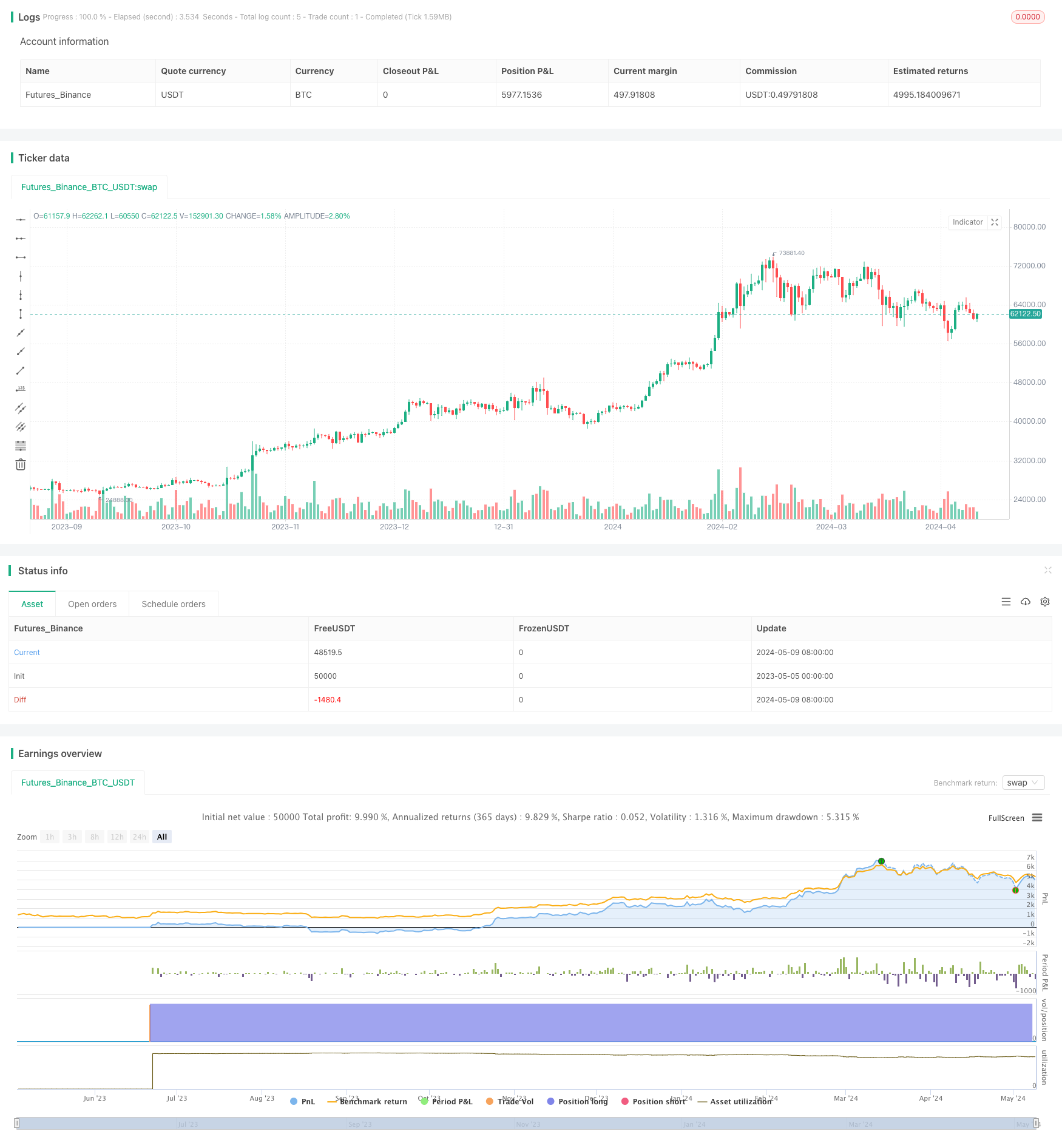
概述
该策略结合了移动平均线(MA)和相对强弱指数(RSI)两个技术指标,通过快慢移动平均线的交叉和RSI的超买超卖信号来生成买卖信号。当快速移动平均线上穿慢速移动平均线且RSI高于超卖阈值时,产生买入信号;当快速移动平均线下穿慢速移动平均线或RSI高于超买阈值时,产生卖出信号。
策略原理
该策略利用了移动平均线和相对强弱指数两个技术指标的特性。移动平均线能够反映价格的趋势方向,快速移动平均线对价格变化更敏感,慢速移动平均线反应相对滞后。当快速移动平均线上穿慢速移动平均线时,表明价格趋势向上,可能是买入机会;反之则表明价格趋势向下,可能是卖出机会。相对强弱指数衡量一段时间内价格的涨跌幅度,当RSI高于超买阈值如70时,表明市场可能过热,价格存在回调风险;当RSI低于超卖阈值如30时,表明市场可能过冷,价格存在反弹机会。
通过结合移动平均线的趋势特性和相对强弱指数的超买超卖特性,该策略能够捕捉趋势行情,同时规避部分超买超卖风险,是一个兼具趋势跟踪和均值回归的量化策略。
策略优势
- 简单易用:该策略逻辑清晰,只使用了两个常用技术指标,适合量化交易新手学习使用。
- 趋势跟踪:通过快慢移动平均线的交叉,策略能够顺应价格趋势方向进行交易。
- 风险控制:引入相对强弱指数作为辅助判断,在趋势交易的同时,控制了部分超买超卖风险。
- 适应性强:移动平均线和相对强弱指数的参数可以根据不同市场特点进行优化,具有良好的适应性。
策略风险
- 参数敏感:移动平均线和相对强弱指数的计算周期参数对策略性能影响较大,不同参数可能产生不同结果。
- 震荡市风险:当市场呈现宽幅震荡走势时,该策略可能产生较多虚假信号,导致亏损加大。
- 趋势转折风险:当市场趋势发生转折时,该策略可能出现连续亏损的情况。
- 不考虑基本面:该策略完全基于价格走势,没有考虑宏观经济、行业趋势等基本面因素的影响。
策略优化方向
- 参数优化:通过对历史数据进行回测,寻找最优的移动平均线和相对强弱指数参数组合,提高策略稳定性。
- 引入趋势过滤:加入长期移动平均线或价格通道等趋势过滤指标,确认大趋势后再进行交易,减少震荡市的虚假信号。
- 止损止盈:设置合理的止损止盈条件,控制单次交易风险,提高策略收益风险比。
- 仓位管理:根据市场趋势强度、价格波动等因素动态调整仓位,减小趋势转折时的回撤幅度。
- 多因子结合:结合量价指标、情绪指标等其他技术指标,构建多因子模型,提高策略稳健性。
总结
移动平均线与相对强弱指数策略是一个简单实用的量化交易策略,通过趋势跟踪和超买超卖判断,在把握市场趋势的同时控制部分风险。但该策略也存在参数敏感、震荡市和趋势转折风险等问题,需要通过参数优化、趋势过滤、资金管理等方式进一步改进。此外,量化交易者还需结合自身风险偏好和市场特点,灵活调整策略,并与其他信号因子相结合,以获取更稳健的收益。
策略源码
/*backtest
start: 2023-05-05 00:00:00
end: 2024-05-10 00:00:00
period: 1d
basePeriod: 1h
exchanges: [{"eid":"Futures_Binance","currency":"BTC_USDT"}]
*/
// This Pine Script™ code is subject to the terms of the Mozilla Public License 2.0 at https://mozilla.org/MPL/2.0/
// © giancarlo_meneguetti
//@version=5
strategy("GM.MA.RSI.Stra", overlay=true, default_qty_type=strategy.percent_of_equity, default_qty_value=10)
// Configurações para Médias Móveis
ema_short_length = input(9, title="EMA.9")
ema_long_length = input(21, title="EMA.21")
ema_short = ta.ema(close, ema_short_length)
ema_long = ta.ema(close, ema_long_length)
// Configurações para RSI
rsi_length = input(14, title="RSI.14")
rsi_upper_threshold = input(70, title="RSI>70")
rsi_lower_threshold = input(30, title="RSI<30")
rsi = ta.rsi(close, rsi_length)
// Sinais de Compra e Venda
// Sinal de Compra quando a EMA curta cruza acima da EMA longa e o RSI está acima do limite inferior
buy_signal = ta.crossover(ema_short, ema_long) and rsi > rsi_lower_threshold
// Sinal de Venda quando a EMA curta cruza abaixo da EMA longa ou o RSI está acima do limite superior
sell_signal = ta.crossunder(ema_short, ema_long) or rsi > rsi_upper_threshold
// Geração de Alertas
alertcondition(buy_signal, title="Sinal de Compra", message="A EMA curta cruzou acima da EMA longa e o RSI está acima do limite inferior. Considere comprar.")
alertcondition(sell_signal, title="Sinal de Venda", message="A EMA curta cruzou abaixo da EMA longa ou o RSI está acima do limite superior. Considere vender.")
// Execução da Estratégia
if buy_signal
strategy.entry("Compra", strategy.long)
if sell_signal
strategy.close("Venda")
相关推荐